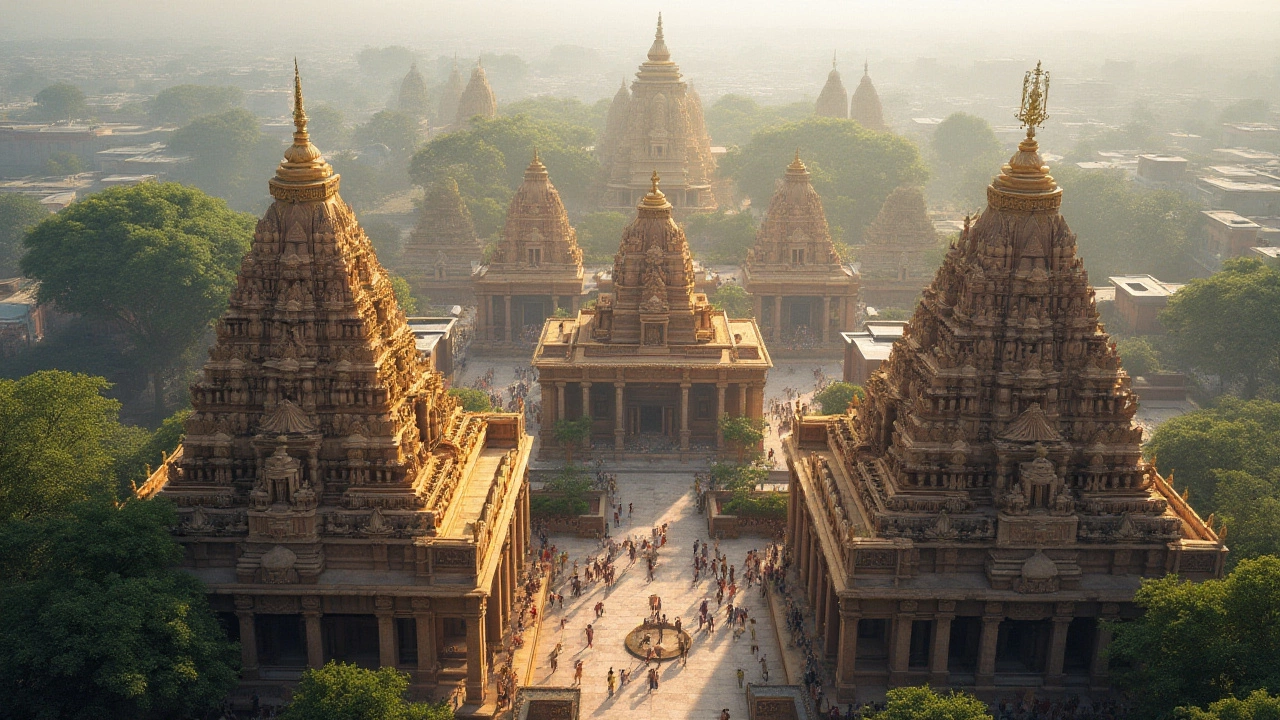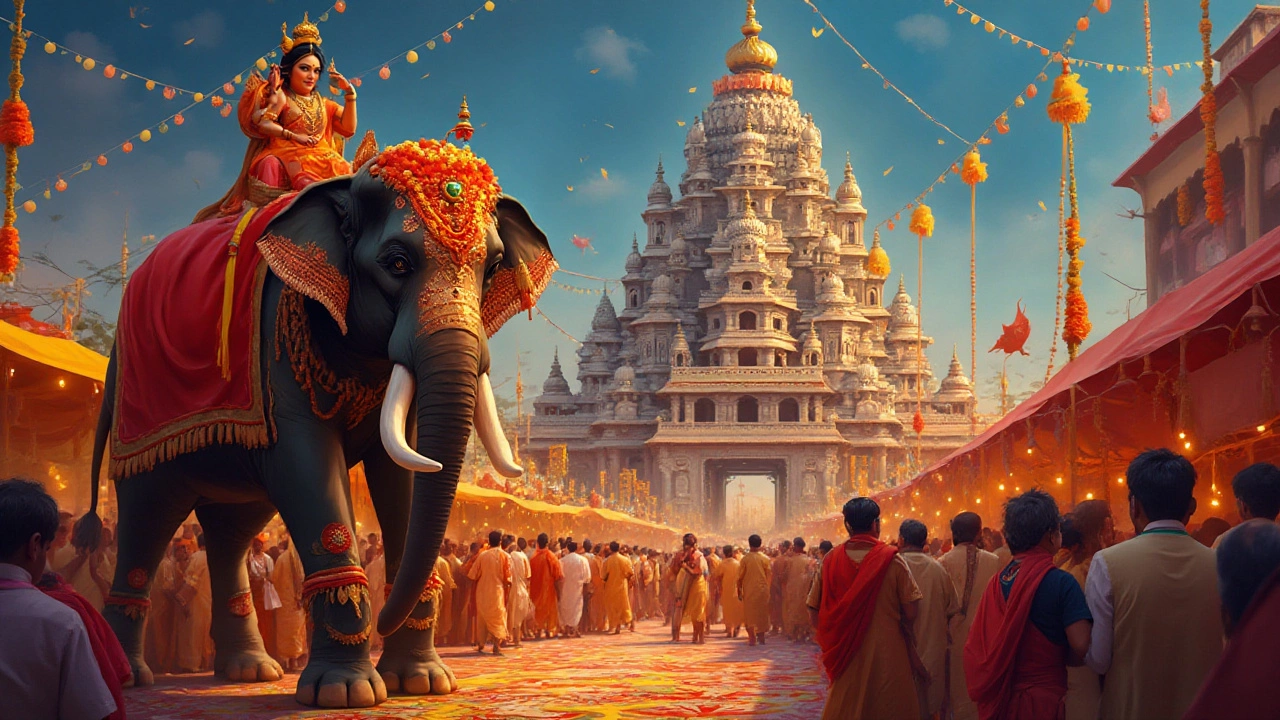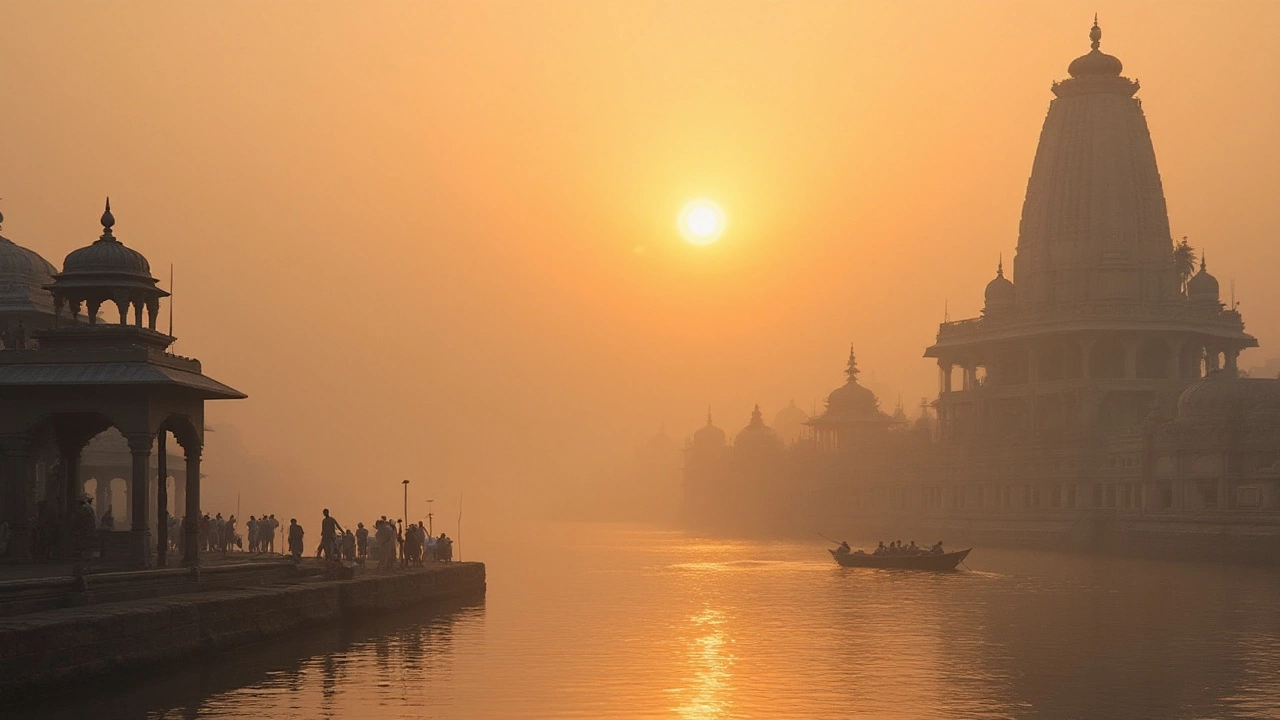Discovering India's Temple Treasures: A State-by-State Exploration

- Feb, 4 2025
- 0 Comments
- Aaron Blackwood
India's temples are not just architectural marvels; they're gateways to the country's soul. With thousands of years of history etched in their walls, these sacred spaces whisper tales of devotion, power, and passion. Navigating the vast tapestry of India's temple landscape is as exciting as it is humbling, offering insights into the spiritual pulse that beats across the subcontinent.
In this rich mosaic of divinity, some states stand out for their sheer volume of renowned temples. Tamil Nadu, for instance, is often hailed as the land of temples, dotted with intricately carved structures that pay homage to myriad deities. Yet, Uttar Pradesh, with its significant spiritual heritage sites, also claims a significant place in the annals of temple glory.
Wondering which state takes the crown for hosting more famous temples? Let's embark on a journey that takes you beyond the popular to the lesser-known yet equally captivating treasures. Buckle up as we unravel the spiritual wonders spread across India's diverse states and offer tips on making the most of your temple tours.
- Introduction to India's Temple Heritage
- A Glimpse into Tamil Nadu's Temple Abundance
- Uttar Pradesh: Land of Pilgrimage and Power
- Temples Beyond the Famous: Underrated Gems
- Tips for a Memorable Temple Tour in India
Introduction to India's Temple Heritage
India's temples are more than mere places of worship; they are a profound testament to the nation's historical and cultural journey. Across its length and breadth, the country hosts a myriad of famous temples that reflect the intricate tapestry of Indian civilization. From the snow-capped peaks of the Himalayas to the sun-kissed shores of the southern coasts, each temple holds within it stories of devotion, architectural brilliance, and the unyielding spirit of its creators.
The practice of temple building in India dates back to some 2000 years, and it has undergone a remarkable evolution over centuries. The oldest structures were initially made of wood, later transitioning to stone as a more permanent and durable medium. Today, these structures are not only religious sanctuaries but also architectural wonders that attract millions of visitors worldwide.
Architectural Marvels
The architectural styles of Indian temples vary significantly across regions. In the South, the temples of Tamil Nadu are particularly renowned for their towering gopurams (gateway towers) adorned with multicolored sculptures of gods and demons. The iconic Brihadeeswarar Temple in Thanjavur is a prime example, showcasing the grandeur of Chola dynasty architecture.
Moving north, the temples in the state of Uttar Pradesh, such as the Kashi Vishwanath Temple in Varanasi, stand as ancient cronicles of India's spiritual narrative. These temples, embedded within cityscapes, symbolize the integral role of spirituality in daily life.
The Sacred Essence
Every temple carries a unique narrative, a history steeped in mythology and enriched by the beliefs of countless devotees. An Indian philosopher, Dr. Radhakrishnan, once said,
"The temples of India are not mere places of worship, they are the living embodiments of Indian culture and tradition."This sentiment resonates deeply as each temple has a story to tell, a deity it venerates, and a community it nurtures.
Understanding India's temple heritage is akin to decoding a history book written in stone. These temple tours offer more than just a spiritual journey; they provide a window into the country's soul, where past meets the present in an elegant dance of faith and artistry.
A Glimpse into Tamil Nadu's Temple Abundance
When one thinks of Tamil Nadu, the rich culture, vibrant festivals, and remarkable architecture invariably paint a vivid picture of its vast temple landscape. This southern state is renowned across India and beyond as the land of temples, with over 33,000 ancient temples scattered across its terrain, some dating back over a thousand years.
Among these, the Brihadeeswarar Temple in Thanjavur reigns supreme. A UNESCO World Heritage site, this majestic temple, built by Chola king Raja Raja Chola I in the 11th century, stands as an epitome of Chola architecture. Its towering vimana, or temple tower, stretches to a staggering height of 66 meters, made even more impressive by the precision with which it was constructed without modern machinery.
The Dravidian Architecture Marvels
The Dravidian style of architecture defines many of Tamil Nadu's temples, characterized by towering gopurams (gateway towers), intricate sculptures, and sprawling compounds. The Meenakshi Amman Temple in Madurai exemplifies this style. With its thousand-pillared hall and celestial sculptures, it's not just a place of worship but a celebration of art and religious fervor.
The Sanctuaries of Kanchipuram
Kanchipuram, often touted as the 'City of a Thousand Temples', is a cornerstone of Hindu spirituality. The city is adorned with temples like the Kailasanathar Temple, known for its remarkable stone carvings and murals. Believers and architecture enthusiasts alike flock here to witness the serenity and beauty of what is considered a perfect blend of spirituality and craft.
- Brihadeeswarar Temple - Thanjavur
- Meenakshi Amman Temple - Madurai
- Kailasanathar Temple - Kanchipuram
Did you know? Tamil Nadu's temples not only reflect religious devotion but also serve as centers for social and educational activities throughout history.
Whether it’s the grandeur of the temples themselves, the resonating chants of priests, or the ornate festivals celebrated with fervor, Tamil Nadu's temples provide a spiritual and cultural richness that beckons explorers from all corners of the globe. It's not just about the structures; it's an experience—a journey through time, history, and faith.

Uttar Pradesh: Land of Pilgrimage and Power
Uttar Pradesh, a state saturated with spiritual and historical significance, stands as a pillar of India's temple treasures. It boasts an amalgam of sacred sites that bear testimony to epochs of religious fervor and grandeur. A journey through this region is a pilgrimage to the spiritual heart of India, providing a profound connection to divinity and history alike.
Ancient Cities and Revered Sites
At the forefront of Uttar Pradesh's spiritual landscape is Varanasi, often hailed as the world's oldest living city. Pilgrims frequent its ghats, especially the revered Dashashwamedh Ghat, where rituals and prayers provide a daily spectacle against the backdrop of the holy Ganges.
Adjacent to Varanasi is the legendary city of Sarnath, where Gautama Buddha delivered his first sermon, marking a pivotal moment in Buddhist history. The Dhamek Stupa here is not just a significant landmark but a reminder of the timeless dissemination of peace.
Prayagraj, known for its Kumbh Mela, the largest human gathering on the planet, is another powerhouse in the state's spiritual circuit. Its confluence of the Ganges, Yamuna, and the mythical Saraswati rivers, known as Triveni Sangam, attracts millions who seek spiritual cleansing and enlightenment.
Architectural Marvels
Beyond spiritual gatherings, Uttar Pradesh offers splendid architectural exemplars. The city of Ayodhya, believed to be the birthplace of Lord Rama, proposes a rich tapestry of myth and reality, enshrining places like Ram Janmabhoomi temple amidst new reconstructions.
Mathura and Vrindavan, the playful lands of Lord Krishna, resonate with tales of divine leelas. The ISKCON Temple in Vrindavan and Krishna Janmabhoomi Temple in Mathura are both profound personal and historical experiences that elevate one's spiritual intrigue.
Essential Tips for Temple Tours in Uttar Pradesh
- Timing is essential. Visit during early mornings or late evenings to experience the tranquility and avoid large crowds.
- Dress modestly and be respectful of local customs as these are active places of worship.
- Engage with local guides to unravel lesser-known stories and historical anecdotes, enhancing your journey.
With its vast array of spiritual sanctuaries, Uttar Pradesh serves not only as a repository of religious history but also as a gateway to India's diverse cultural and spiritual narrative. As you wander through its lanes and byways, each temple stands as a timeless witness to India's enduring devotion.
Temples Beyond the Famous: Underrated Gems
While the renowned temples of India often steal the limelight, the country is adorned with myriad hidden gems that are equally divine and mesmerizing. These lesser-known temples provide not just spiritual solace but also architectural brilliance and cultural depth for those who seek beyond the well-trodden paths. Exploring these temples can offer a more intimate glimpse into the profound spirituality of India.
Jageshwar Temple Complex, Uttarakhand
Tucked away in the serene forests of Uttarakhand, the Jageshwar Temple Complex is a meditative cluster of 124 temples. Most dating back to the 9th to 13th centuries, these temples are dedicated to Lord Shiva. Despite its significance, the site remains a retreat for those in search of tranquility. The intricate nagara-style architecture against the backdrop of deodar trees provides a visual feast and spiritual haven.
Lonar Temple, Maharashtra
The Lonar Temple, situated near the fascinating Lonar Crater Lake, is an ancient gem often overshadowed by other holy sites in Maharashtra. Built around the unique saltwater lake formed by a meteoric collision, the temple is dedicated to Lord Vishnu in his Daityasudana avatar. Its historical importance is acknowledged yet rarely celebrated. As ornithologists, geologists, and devotees converge here, it’s a window into how nature and divinity can coexist harmoniously.
Lepakshi Temple, Andhra Pradesh
Standing as a testament to Vijayanagara architectural prowess, Lepakshi Temple is truly underrated. Famous for its hanging pillar—a marvel of engineering—the temple is steeped in legend. It is said that a part of the epic Ramayana was set here. Despite this, it remains less frequented by tourists but offers a rich narrative and intricate carvings that fascinate history enthusiasts.
“India is not an easy country to categorize. It stays with you, and you rarely leave it behind.” — Keith Bellows
Bellows' words resonate deeply as one discovers these temple treasures that stand away from India's famed trails.
- Ranganathittu Bird Sanctuary near Srirangapatna adds a unique touch of biodiversity to the temple tours.
- Kailash Temple in Ellora, though slightly more popular, conceals myriad stories that spark curiosity and awe.
These hidden sanctuaries remind us that spiritual discovery isn't always on a map but often off the beaten path. As you plan your temple tours in India, consider the road less traveled—where history, art, and spirituality intersect in quiet harmony.

Tips for a Memorable Temple Tour in India
Embarking on a temple tour in India can be a transformative experience, blending awe-inspiring architecture with deep-rooted spiritual traditions. To ensure your journey is enriching and unforgettable, here are some practical tips to keep in mind.
Plan Your Itinerary Wisely
India is vast, and so is its treasure trove of famous temples. Start by identifying which states are home to temples that resonate with your interests. For instance, if you're fascinated by Dravidian architecture, Tamil Nadu is a must-visit. On the other hand, those drawn to the legends of Hindu epics might find the holy sites of Uttar Pradesh particularly compelling.
- Research temple timings and special events, as they can enhance the experience.
- Consider visiting during temple festivals for a vibrant cultural experience.
- Balance your itinerary between well-known sites and hidden gems for a broader perspective.
Respect Local Customs
Every temple has its own set of protocols. Observing these customs is essential to show respect and fully appreciate the spiritual ambiance. Here are a few universally applicable guidelines:
- Dress modestly, covering shoulders and knees, as a sign of respect.
- Leave footwear outside the temple premises.
- Avoid taking photos inside sanctums unless explicitly allowed.
- Partake in rituals and offerings if open to it, as it deepens the engagement.
Stay Informed
A little background knowledge goes a long way. Understanding the historical and mythological significance of the temples can enrich your visit. Hiring a knowledgeable guide or using a reliable guidebook can bring stories and legends to life. Here’s a brief overview of states with a high concentration of renowned temples:
| State | Number of Famous Temples |
|---|---|
| Tamil Nadu | Over 33,000 |
| Uttar Pradesh | Approximately 25,000 |
| Karnataka | Near 30,000 |
Mind the Seasons
India's climate varies dramatically, affecting travel conditions. The winter months (November to February) are generally the most pleasant for exploration across the country. During monsoons, some regions may be difficult to traverse, and open-air temples might be less accessible.
Cherish the Experience
Finally, approach your temple tour with an open heart. Engage with locals, savor traditional prasad offerings, and allow yourself to soak in the spiritual vibes. Each temple is a living beacon of India's rich cultural and spiritual heritage, and your openness to its offerings can transform your journey from a mere sightseeing tour to a soulful pilgrimage.